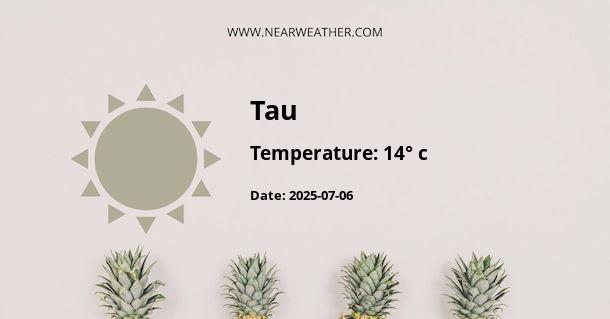Tau, Norway: Climate and Weather Year Round
Tau is a beautiful town located in the municipality of Strand in Rogaland county, Norway. Situated on the western coast of the country, Tau experiences a unique climate that is influenced by its proximity to the North Sea and its geographical location. In this article, we will explore the climate and weather patterns in Tau throughout the year, providing you with detailed and accurate information on what to expect when visiting this picturesque town.
Temperature
When it comes to temperature, Tau experiences a temperate maritime climate. The town benefits from the warming effect of the Gulf Stream, which helps to moderate the temperatures throughout the year. However, due to its northerly latitude, Tau still experiences distinct seasonal variations.
In the summer months of June, July, and August, temperatures in Tau range from an average high of around 18°C (64°F) to an average low of 11°C (52°F). These months are considered the warmest in the year, providing pleasant weather for outdoor activities and exploring the stunning natural surroundings.
As autumn approaches, temperatures begin to cool down. In September and October, the average high ranges from 14°C (57°F) to 9°C (48°F), while the average low hovers between 8°C (46°F) and 4°C (39°F). The autumn season is characterized by beautiful foliage, offering visitors a colorful and scenic experience.
Winter in Tau can be cold, with temperatures dropping below freezing. From December to February, the average high ranges from 4°C (39°F) to 0°C (32°F), while the average low varies between -2°C (28°F) and -6°C (21°F). Snowfall is common during these months, creating a picturesque winter wonderland.
Spring brings milder temperatures to Tau, with an average high of 8°C (46°F) to 10°C (50°F) in March and April. The average low ranges from 2°C (36°F) to 4°C (39°F). As nature awakens from its winter slumber, spring in Tau offers a refreshing and vibrant atmosphere.
Precipitation
Tau receives a significant amount of rainfall throughout the year, following the typical pattern of a maritime climate. The town experiences relatively high levels of precipitation, particularly during the autumn and winter months.
From September to November, Tau sees an increase in rainfall, with an average of 120-140mm per month. The wettest month is typically October, with an average of 140mm of precipitation. As the seasons transition into winter, the rainfall continues, albeit at slightly lower levels.
In the winter months of December to February, Tau experiences an average precipitation of 90-100mm per month. Snowfall is common during this period, adding to the overall precipitation levels. It is important to note that the amount of snowfall can vary from year to year, depending on weather patterns and conditions.
As spring approaches, the rainfall begins to decrease. In March and April, Tau receives an average of 70-80mm of precipitation per month. The transition from winter to spring is often accompanied by occasional showers, contributing to the overall precipitation levels.
During the summer months of June, July, and August, rainfall levels in Tau are relatively lower compared to other seasons. The town receives an average of 60-70mm of precipitation per month during this period. However, it is still advisable to be prepared for occasional showers during your summer visit to Tau.
Wind
Being located on the western coast of Norway, Tau experiences moderate to strong winds throughout the year. The combination of its proximity to the North Sea and the presence of fjords in the region contributes to the wind patterns in the area.
The prevailing winds in Tau come from the southwest, bringing moist and mild air masses from the Atlantic Ocean. These winds can sometimes be strong, especially during storms and periods of low-pressure systems.
It is important to consider the wind factor when planning outdoor activities in Tau, as it can significantly impact your experience. Windproof clothing and proper precautions are recommended, particularly during the winter months when the wind chill factor can make the temperatures feel even colder.
Sunlight
Like many other locations in Norway, Tau experiences significant variations in daylight hours throughout the year due to its high latitude. The phenomenon of the midnight sun and polar nights can be observed in this region.
In the summer months, particularly in June and July, Tau enjoys long daylight hours. The sun does not fully set during this period, resulting in the famous midnight sun phenomenon. Visitors can experience extended daylight, allowing for more time to explore the natural beauty of the area.
On the other hand, during the winter months, Tau experiences polar nights. The sun does not rise above the horizon for several weeks, resulting in limited daylight hours. This creates a unique atmosphere and offers the opportunity to witness the mesmerizing northern lights.
Conclusion
Tau, Norway, offers a remarkable climate and weather experience year-round. From the warm and pleasant summers to the snowy winters and the unique phenomena of the midnight sun and polar nights, this picturesque town has something to offer for every season.
Whether you are a nature enthusiast, an adventure seeker, or simply looking to immerse yourself in the beauty of Norway, Tau provides a diverse and captivating climate that is sure to leave a lasting impression.
A - Tau's Latitude is 59.066669 & Longitude is 5.900000.
A - Weather in Tau is 7° today.
A - Climate Conditions in Tau shows light rain today.
A - Humidity in Tau is 67% today.
A - Wind speed in Tau is 18.72 km/h, flowing at 19° wind direction. today.
